Every NHL season manufactures new storylines, bringing with it a new cast of breakout stars and performers. Underlining these acts is that although several players can flaunt a history of stellar production, their outputs often run much hotter than their career averages. This makes them prime candidates to see a regression in their statistical production, especially when considering the small sample size of playing less than half of the season to this point.
Although regression carries a negative connotation, all the term suggests is that a result or output should move back to its normal, or average, value over time. This can take the form of an upward (think of a snake-bitten forward finally converting on his opportunities) or downward (a player stops scoring on one of every three shots) trajectory. It doesn’t mean that I am calling these players bad or undeserving of their success, only that their numbers should come back to Earth over the rest of the season. With that context in mind, I present five of the NHL’s top regression candidates for the second half of the 2021-22 campaign.
Filip Forsberg, Nashville Predators
According to MoneyPuck, Filip Forsberg is currently second in the NHL in goals scored above expected (GAx), making him our primary candidate that is due for an offensive decline in 2022. Forsberg is tied for seventh in goals at all strengths (18) and his 13 5v5 tallies are good for second place. His current goal pace of 0.69 markers per game translates to a 56-goal rate over an 82-game season, which easily blows past Forbserg’s career-high of 33 goals scored during the 2015-16 campaign.
Further, his current shooting percentage (23.7 SH%) is nearly double his career average of 12.6%, a sure sign that Forbserg’s output over the second half of the season could see a notable shave in production.
If Forsberg maintains his shot rate of 2.92 per game but instead converts at his career norm, he adds 17 more goals to bring him to a hypothetical 35 on the season, which still represents a career-best for the Swedish forward. He’s already surpassed his even-strength goal totals from each of the past two seasons with 15 this season, after potting 14 and nine in the past two respectively.
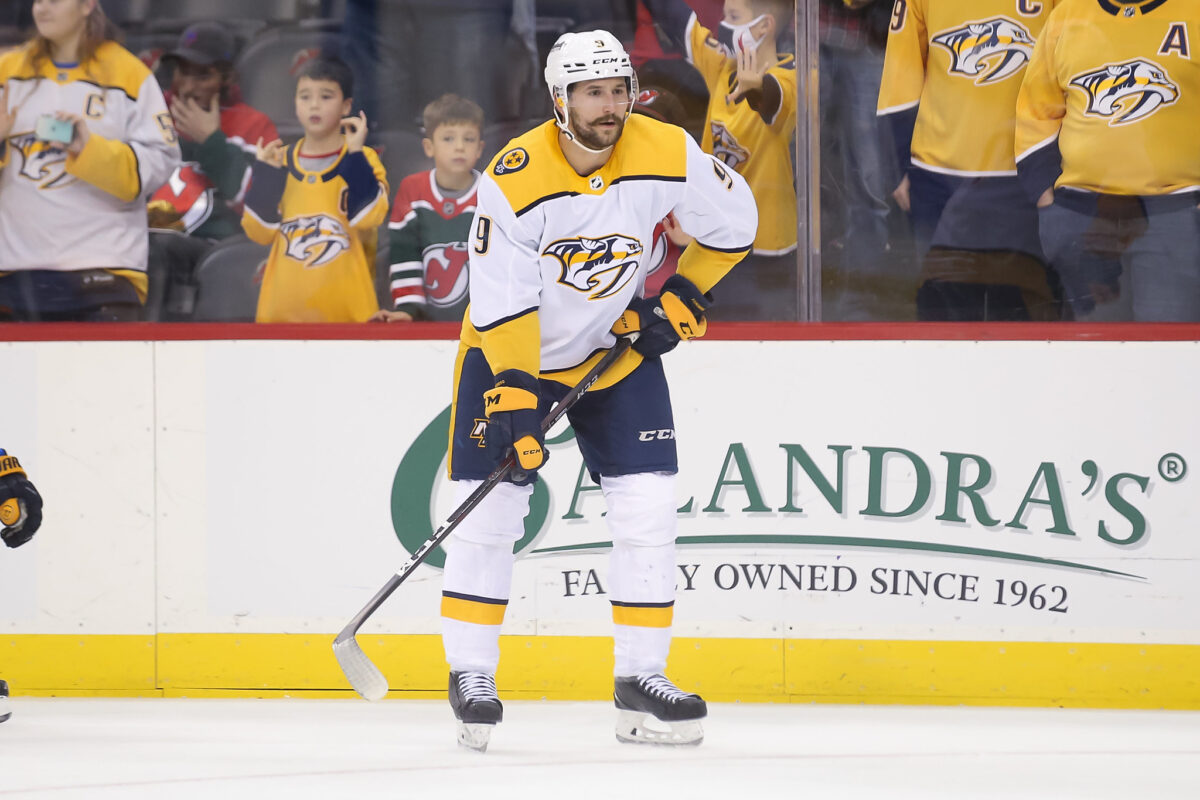
Is the Nashville Predators winger doing enough to mitigate the negative impact of regression? Tough to say, as while his all-situations shot rates (10.85 to 9.72 SH/60) have observed a dip from last season, his individual scoring chance generation has seen a slight uptick from 9.34 to 9.98 iSCF/60.
Considering Forsberg’s history of scoring in this league (five seasons with at least 26 goals) and steady rate of shot attempts, he shouldn’t see his totals tank too much. He definitely isn’t going to keep scoring 2.3 goals per-60 for the rest of the campaign, though.
Adam Boqvist, Columbus Blue Jackets
Next up is the young starlet of the Columbus Blue Jackets‘ blueline, and Adam Boqvist, who is third in GAx among defensemen this season as a result of scoring seven goals against his expected tally (ixG) of 2.3. He ranks second in goals per-60-minutes (1.09) behind only Cale Makar of the Colorado Avalanche among defenders with at least 100 minutes played in all situations.
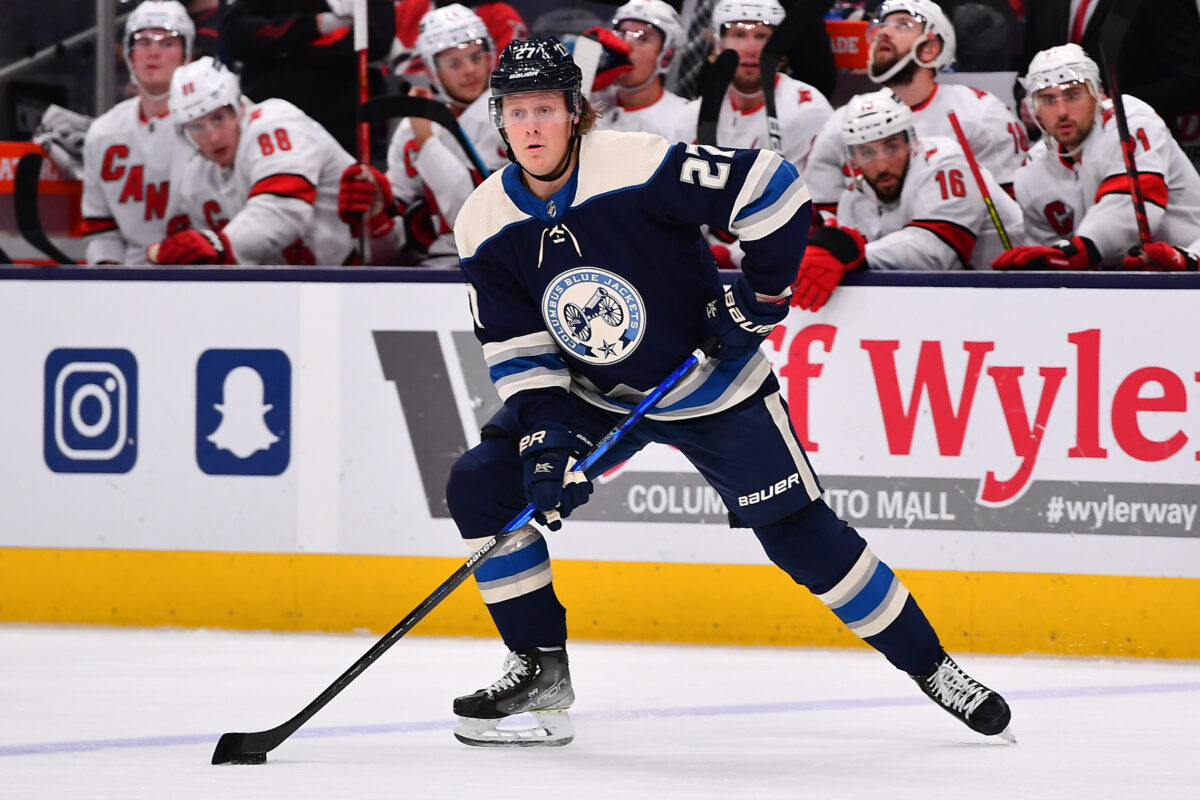
He’s shooting more frequently than in his tenure with the Chicago Blackhawks (he was part of the Seth Jones mega-deal), but his astronomical SH% tells the true story. He’s found the net on over a quarter of his shots to date (25.9%), after posting 8 and 5.1 percent conversion rates in his two seasons with the Blackhawks. Also, Boqvist’s 5v5 SH% (28.57%) easily leads NHL rearguards, nearly a full 12% higher than Makar in second. Clearly, everything he touches turns to gold.
At 5v5, Boqvist posts unassuming per-60 rates in shots (150th among defenseman with 100 minutes played), but he ranks favorably in terms of scoring chances (42nd), high-danger opportunities (37th), and ixG/60 (14th). He doesn’t get very many attempts on goal, but the ones he’s managed to release are taken from quality areas.
Related: NHL’s 5 Most Surprising Players of 2021-22
The quality of his chances is a promising development, but his unsustainable conversion percentage throws things into disarray. On the other hand, Boqvist possesses a prestigious draft pedigree, and a part of his increased output could be attributed to the young defender finally blossoming into his potential. Keep an eye on him in the season’s second half, especially with Patrik Laine returning to the fold.
Nazem Kadri, Colorado Avalanche
While most of the candidates on this list are being named for their exorbitant goal-scoring, Nazem Kadri lands here due to his staggering point totals.
His 44 points in 28 games is easily a career-best per-game (P/G) output, and the Avalanche center is only 17 points off of his highest-scoring season in the NHL (61 in 2016-17) with 51 games left on the schedule. Even if he reverts back to his career average of 0.67 P/G, he’d finish the season with 78 points. He also leads the NHL in points per-60 (5.12) and is second in assists (3.72 per-60), sitting fifth-overall in total points.
So, what’s stopping Kadri from maintaining his impressive surge in production? Apart from this season deviating wildly from his typical output, he’s benefitted from more clinical finishing from his linemates. Kadri’s 5v5 OiSH% (13.54%) is the second-highest of his career and the most prolific mark since the shortened 2012-13 season.
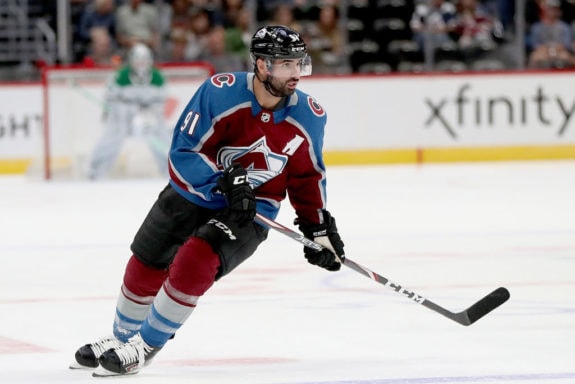
Three of Kadri’s most frequent linemates at 5v5 are Andre Burakovsky (21.8 SH%), Valeri Nichushkin (21.3), and Cale Makar (19.5), a trio of players all shooting well above their career norms. On the power play, Kadri has featured extensively on the top unit, most often sharing the ice with Makar and Colorado’s vaunted first-line. Kadri’s traits complement the Avalanche stars, but his numbers aren’t sustainable to this degree.
Colorado’s carousel of injuries to start the year meant that Kadri often found himself elevated into primary scoring roles at even-strength and on the power play. With a more stable lineup, he won’t be afforded the same opportunities to lead the attack, even if he stays in the top-six forward group.
Related: NHL’s 3 Most Surprising Teams of 2021-22
Kadri’s rise in production has been a blessing for a frequently wounded Avalanche side, and the fact that it’s happening in a contract year for the pending unrestricted free agent surely brings a smile to his agent’s face. In any case, assuming it continues at the same level is a risky bet to place. Any prospective suitors should be wary of handing him a big-ticket contract this offseason, even if he remains a solid investment at a lower price.
Chandler Stephenson, Vegas Golden Knights
Apart from Kadri, there might not be another player on the scoring leaderboard who induces a raising of the eyebrows as often as Chandler Stephenson. The Vegas Golden Knights‘ utility forward leads the team in scoring with 35 points in 37 games, matching his total from last season in 14 fewer appearances.
The injuries to Max Pacioretty (22 games missed) and Mark Stone (17) pumped up Stephenson’s usage to 19:27 minutes a night, almost a minute and a half higher than his previous career-high. Since the pair have returned, they’ve been two of Stephenson’s three most frequent forward linemates at 5v5, giving him two strong running mates to shield him from increased defensive attention.
Although he’s not being boosted by an abnormally elevated SH%, his Individual Point Percentage (IPP) ratio – the percentage of goals on which a player earned a point – is a cause for concern. According to Travis Yost, the average IPP value for forwards hovered around 68% as of 2015. It’s a few years out of date, but I’d assume that the number hasn’t changed much over the years. Although Stephenson’s IPP is slightly above-average, that’s not the underlying issue.
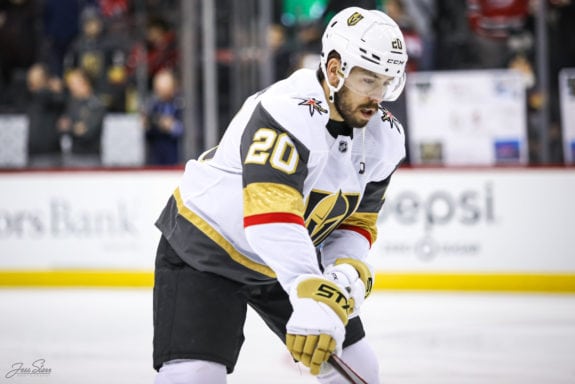
Stephenson’s 72.7% IPP in 2021-22 is the highest of his NHL career and is around 20% greater than in his two other seasons in Vegas. Either Stephenson suddenly transformed into a dynamic offensive star, or he’s riding a wave of favorable puck luck. His previous results suggest it’s more of the latter, meaning he’s one to watch.
Additionally, Stephenson’s point totals are buoyed by a high number of secondary assists. He’s currently the NHL leader in secondary helpers in all situations (16) and at 5v5 (11), suggesting he’s not as involved in the offense as his numbers might indicate. Further, research shows that secondary assists are not as repeatable as primary assists. As a result, Stephenson could struggle to replicate his early form in 2022.
Related: NHL’s 5 Most Disappointing Players of 2021-22
There’s also the return of Jack Eichel to the Golden Knights lineup to consider. When healthy, Vegas could trot out a first-line centered by Eichel, which relegates Stephenson from his plum gig riding shotgun with Pacioretty and Stone. Pacioretty’s recent injury setback buys Stephenson more time to stake his claim to extended top-line minutes, but his spot is in greater jeopardy whenever the roster returns to full strength.
Troy Terry, Anaheim Ducks
The NHL record for the highest SH% in a single season among active players (minimum 20 goals scored) is the 23.4% posted by William Karlsson in the Vegas Golden Knights’ inaugural season. His 43 goals in 2017-18 carried the team on a fairy-tale run to the Stanley Cup Final where they succumbed to the Washington Capitals in five games.
Through nearly half of the 2021-22 season, Troy Terry of the Anaheim Ducks is tracking to eclipse that historic mark. Terry boasts a 25.3 SH% after scoring 21 goals on 83 shots this season, just under one percent greater than that of the Golden Knights’ two-way center.
He is currently tied for fourth in both overall and 5v5 (11) scoring, underlining a remarkable breakout campaign for the American winger. In fact, Terry was considered a darkhorse Olympic pick for Team USA before the NHL pulled out of Beijing, demonstrating his meteoric rise in league circles.
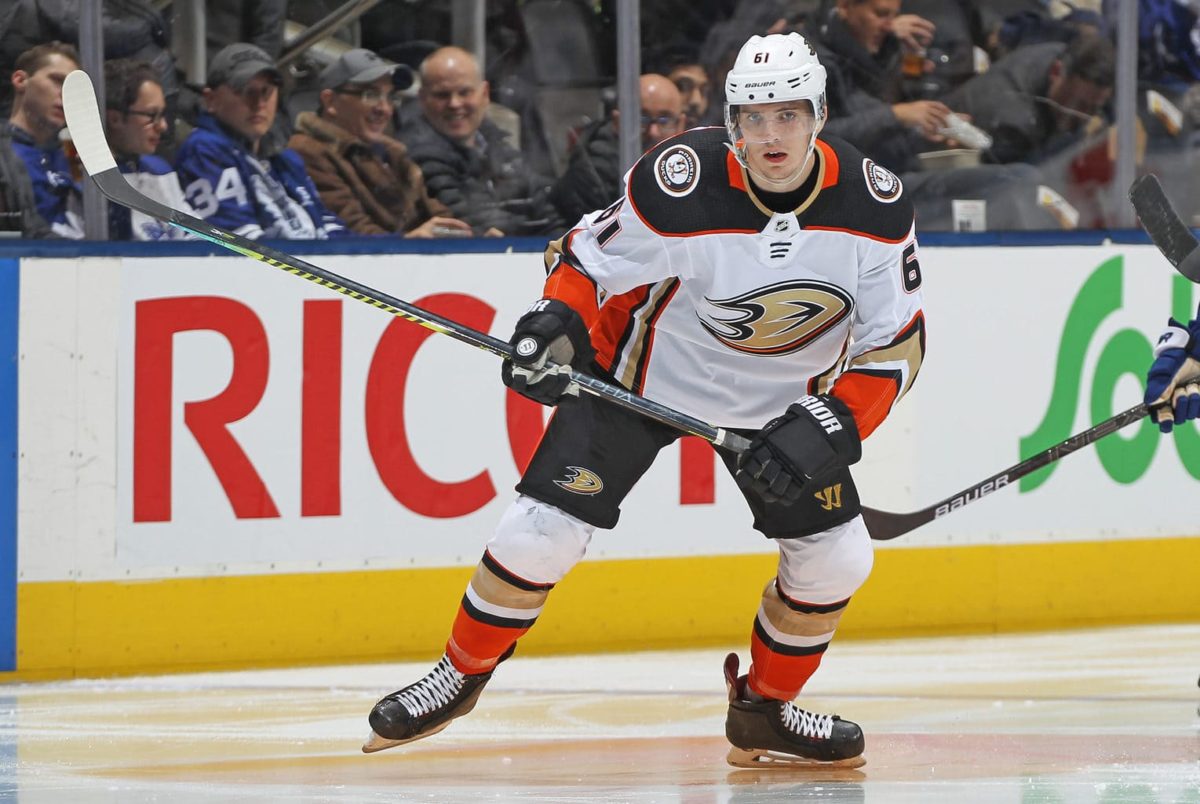
Unfortunately, things might not be as they seem with Terry. He sits third in GAx (9.1) in the NHL, and his SH% is over 11% higher than his career average. Even more extraordinary is Terry’s conversion on the power play. The Ducks forward has taken only 12 shots with the man advantage this season, scoring on exactly half of them.
For reference, only 27 players since 2007-08 have maintained a power-play SH% of 40 percent over an entire season (minimum 100 PP minutes played). Of the 27, nine finished with fewer shots on goal than Terry has already fired this season. If he continues to function as a focal point in the Ducks’ power-play structure, it’s difficult to envision his conversion standing up over the entire year as he takes more shots.
Related: NHL’s 3 Most Disappointing Teams of 2021-22
To be fair to Terry, even though he’s among the league leaders in GAx, he’s not relying entirely on unsustainable shooting to increase his totals. He’s accrued the 33rd most ixG according to MoneyPuck, and his SH/60 rate jumped almost by almost two per game since last season. Still, the historically incendiary SH% argues that his finishing streak won’t continue, and a dip in production could follow once the magic wears off.
2022 Promises Another Year of Surprises in the NHL
Although the specter of regression stalks each of the five players on this list, they may escape the 2021-22 season unscathed. While regression states that statistical results always revert back to their career norms over time, it’s impossible to predict just how long that hot (or cold) streak could last. After a certain length of time, the public must accept that yes, a player is talented enough to regularly outperform their expected output. Is there anyone missing from this list? Let me know in the comments.
Honorable Mentions: Ryan Hartman, Minnesota Wild; Andre Burakovsky, Colorado Avalanche; Erik Karlsson, San Jose Sharks; Jared McCann, Seattle Kraken; Jonathan Quick, Los Angeles Kings
Data courtesy of Evolving Hockey, Hockey Reference, MoneyPuck, and Natural Stat Trick.